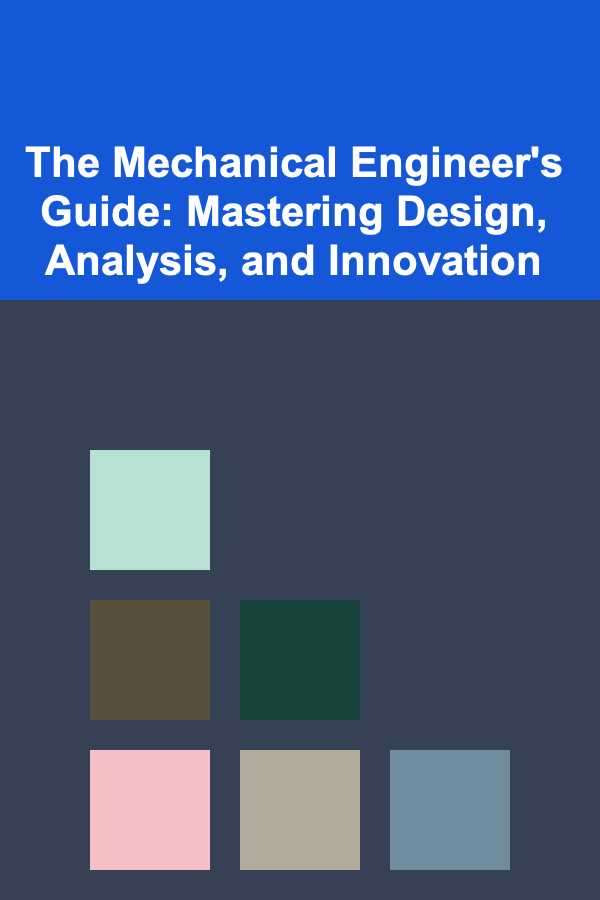
The Mechanical Engineer's Guide: Mastering Design, Analysis, and Innovation
ebook include PDF & Audio bundle (Micro Guide)
$12.99$11.99
Limited Time Offer! Order within the next:

Mechanical engineering is one of the most versatile and foundational disciplines in the world of engineering. From the design of everyday products to the development of cutting-edge technologies, mechanical engineers shape our modern world in significant ways. Whether designing components for machines, analyzing forces, or developing innovative solutions, mechanical engineers must possess a wide range of technical skills, creativity, and critical thinking abilities.
This actionable guide provides mechanical engineers with the tools and strategies needed to excel in their field. From mastering design principles and performing precise analyses to fostering innovation, this guide will help you navigate the multifaceted world of mechanical engineering.
Mastering Design Fundamentals
Design is at the heart of mechanical engineering. Whether you are designing a small part or an entire system, the process requires a blend of creativity, technical knowledge, and problem-solving skills. Mastering the design fundamentals is essential for ensuring that your designs are both functional and feasible.
Actionable Steps for Effective Design:
- Understand the Design Requirements: Before you start designing, it's crucial to understand the project's objectives and constraints. These can include performance requirements (e.g., strength, speed, efficiency), environmental factors (e.g., temperature, pressure), and material limitations.
- Use Engineering Principles: Leverage core mechanical engineering principles like statics, dynamics, thermodynamics, and fluid mechanics to guide your designs. A solid understanding of these principles will ensure that your designs are both functional and safe.
- Embrace Iterative Design: Good design often requires multiple iterations. Don't expect your first design to be perfect. Prototyping, testing, and refining your design based on real-world performance will help improve its efficiency and reliability.
- Utilize CAD Software: Computer-Aided Design (CAD) tools, such as SolidWorks, AutoCAD, and CATIA, are integral to modern mechanical design. These tools enable you to create detailed 2D and 3D models, simulate how components will behave, and identify potential design flaws early.
- Factor in Manufacturing Processes: Always consider how your design will be manufactured. Some designs may look great on paper but can be difficult or costly to produce. Understanding manufacturing methods, such as CNC machining, injection molding, and additive manufacturing, will help you design more manufacturable products.
Example:
Consider designing a mechanical component for an automotive system, such as a bracket for a suspension system. You would begin by understanding the loads it will endure, the material it will be made of, and the manufacturing constraints. After creating an initial design using CAD, you would simulate the stress distribution and make adjustments before finalizing the prototype.
Conducting Thorough Analysis
Mechanical engineers must have a keen eye for detail, especially when it comes to analyzing forces, materials, and system behaviors. Analysis helps engineers predict how a design will perform under different conditions, ensuring that it meets the necessary specifications and safety standards.
Actionable Steps for Effective Analysis:
- Stress and Strain Analysis: Use Finite Element Analysis (FEA) software to predict how forces will affect your design. By analyzing stress, strain, and displacement, you can identify potential failure points before physical testing. FEA is an indispensable tool for ensuring that your components will perform under real-world conditions.
- Thermal Analysis: If your design will operate in environments with temperature fluctuations, perform a thermal analysis. Tools like Computational Fluid Dynamics (CFD) can help you understand how heat will flow through your system and how components will expand or contract in response to temperature changes.
- Vibration and Dynamic Analysis: Many mechanical systems are subject to vibrations, which can lead to fatigue and failure over time. Use dynamic analysis tools to evaluate how vibrations will affect your design, especially for systems that involve rotating parts, such as engines or turbines.
- Material Selection: Analyze the properties of different materials to choose the best one for your design. Mechanical engineers must consider factors such as strength, ductility, fatigue resistance, and thermal conductivity when selecting materials for a given application.
- Safety and Reliability Analysis: Safety is paramount in mechanical engineering. Conduct reliability analysis, including failure modes and effects analysis (FMEA), to identify potential risks in your design and address them before they result in problems.
Example:
For a wind turbine blade design, you would need to conduct both stress and aerodynamic analysis. Using FEA, you would simulate the stresses caused by wind forces, while CFD simulations would help you understand airflow patterns. Thermal analysis would ensure that the blade material can withstand temperature fluctuations in high-altitude environments.
Fostering Innovation
Innovation is the driving force behind progress in mechanical engineering. As a mechanical engineer, you must continuously push the boundaries of what's possible, whether that means developing new materials, improving manufacturing techniques, or creating entirely new systems. Innovation requires a combination of creativity, technical expertise, and a willingness to challenge the status quo.
Actionable Steps to Foster Innovation:
- Stay Informed About New Technologies: Keep up-to-date with the latest advancements in materials science, manufacturing technologies, and computational tools. Attend industry conferences, read research papers, and participate in online forums to stay informed about emerging trends.
- Engage in Cross-Disciplinary Collaboration: Mechanical engineering does not exist in a vacuum. Collaborate with engineers from other disciplines, such as electrical, software, and civil engineering, to bring fresh perspectives and innovative ideas to your projects.
- Encourage a Creative Environment: Innovation thrives in an environment that encourages experimentation and free thinking. Work in teams where brainstorming and idea sharing are encouraged. Don't be afraid to fail---failure can be an important part of the innovation process, as it often leads to new insights and breakthroughs.
- Experiment with Emerging Technologies: Investigate how new technologies like artificial intelligence (AI), machine learning, or advanced robotics can be applied to mechanical systems. These technologies offer the potential to significantly enhance the performance and capabilities of mechanical systems.
- Challenge Conventional Methods: Don't be afraid to question existing designs or manufacturing methods. Often, the most innovative solutions come from rethinking traditional approaches. Consider alternative materials, novel manufacturing techniques, or unconventional design principles to create more efficient and sustainable products.
Example:
In the field of aerospace engineering, innovation has led to the development of lighter, more fuel-efficient materials. For instance, researchers have been experimenting with carbon fiber composites, which are stronger and lighter than traditional metals, improving the overall performance and fuel efficiency of aircraft.
Sustainable Design and Engineering Ethics
As the world increasingly focuses on sustainability, mechanical engineers play a pivotal role in developing environmentally friendly technologies. Sustainable design involves considering the environmental impact of your work and striving to minimize negative effects. Engineers must also adhere to ethical principles that ensure their designs are safe, equitable, and beneficial to society.
Actionable Steps for Sustainable Design:
- Life Cycle Analysis (LCA): Conduct a life cycle analysis of your design to assess its environmental impact from production to disposal. This includes evaluating energy consumption, waste generation, and the carbon footprint of your design.
- Optimize Resource Usage: Minimize the use of non-renewable resources by opting for recyclable materials or designing products that are energy-efficient and have a long lifespan. Incorporating renewable energy sources into your designs can also reduce their environmental impact.
- Design for Disassembly: Where possible, design your products so that they can be easily disassembled at the end of their life cycle. This approach facilitates recycling and reduces waste.
- Ethical Considerations: Always consider the broader impact of your designs. Will they benefit society as a whole? Are they safe? Does the design uphold ethical standards, particularly in areas like safety, health, and environmental protection?
Example:
A mechanical engineer working in the consumer electronics industry might focus on designing energy-efficient appliances. By utilizing materials that are recyclable and designing components that can be easily separated for recycling, the engineer contributes to reducing e-waste and conserving resources.
Continuous Learning and Professional Development
Mechanical engineering is an ever-evolving field. As new technologies emerge and industry standards shift, it's vital for engineers to continue learning and developing their skills.
Actionable Steps for Ongoing Development:
- Advanced Degrees and Certifications: Consider pursuing advanced degrees or professional certifications to deepen your expertise. Specialized certifications in areas like HVAC, robotics, or project management can make you more versatile and valuable in your career.
- Mentorship: Seek out mentors who can offer guidance and help you navigate complex projects or career decisions. Additionally, mentoring younger engineers can help you sharpen your own skills and knowledge.
- Engage in Professional Networks: Join professional organizations such as the American Society of Mechanical Engineers (ASME) to network with other engineers, attend workshops, and stay up-to-date with industry trends.
Example:
If you're interested in robotics, you might pursue a certification in automation or robotics engineering. This additional training can help you design more advanced, efficient robotic systems.
Conclusion
Mechanical engineering is a dynamic and rewarding field that requires a diverse skill set, combining technical knowledge, creativity, and problem-solving abilities. By mastering design principles, performing thorough analyses, fostering innovation, and embracing sustainability, you can excel in this discipline and contribute to the development of technologies that shape the future.
Continuous learning and collaboration with others are essential for staying at the forefront of this ever-evolving field. Whether you're designing cutting-edge machinery, improving manufacturing processes, or creating sustainable solutions, your work as a mechanical engineer has the potential to make a profound impact on the world.

How to Create a Cozy Winter Wonderland at Home
Read More
How to Keep Your Rental Property Safe from Theft and Vandalism
Read More
How to Remove Stubborn Stains from Your Upholstery
Read More
How to Use Sound Engineering Skills to Make Money
Read More
How to Use Video Marketing for Profit
Read More
10 Tips for Writing a Compelling Sociology Paper
Read MoreOther Products

How to Create a Cozy Winter Wonderland at Home
Read More
How to Keep Your Rental Property Safe from Theft and Vandalism
Read More
How to Remove Stubborn Stains from Your Upholstery
Read More
How to Use Sound Engineering Skills to Make Money
Read More
How to Use Video Marketing for Profit
Read More